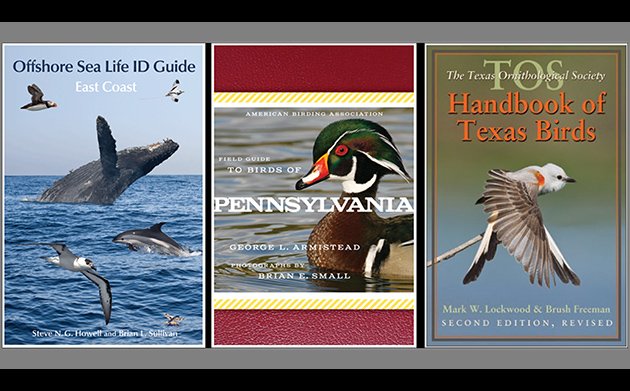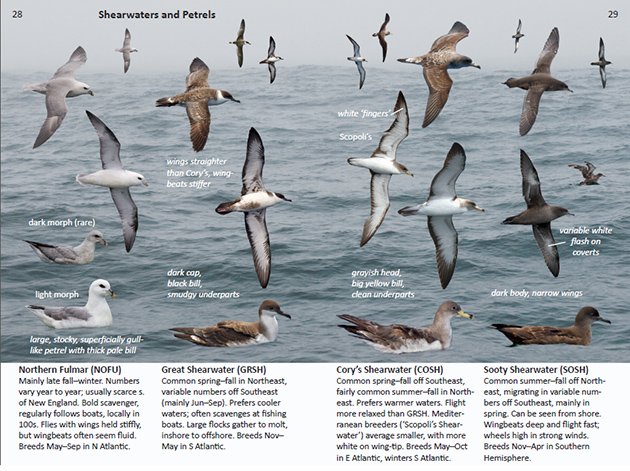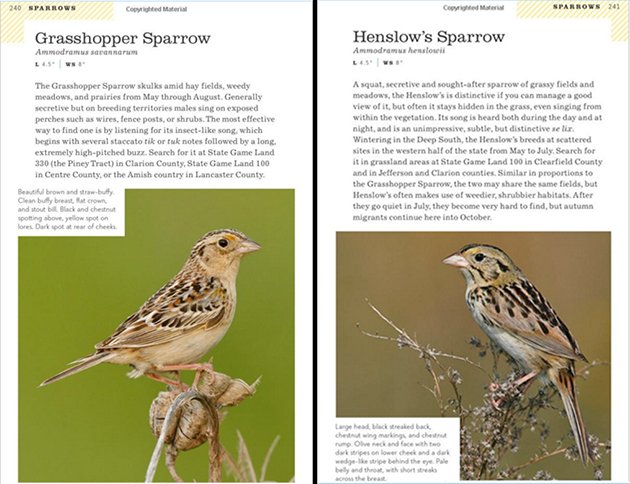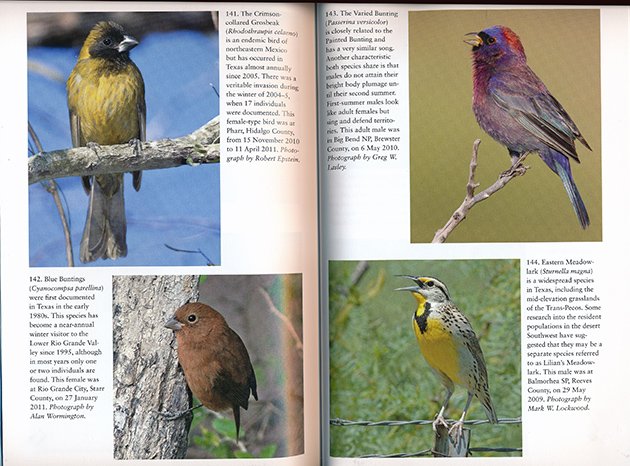
It’s time for some short book reviews. Well, short for me. All of these titles deal with birding in specific North American geographic areas: The Atlantic coast, Pennsylvania, and Texas. Two books are part of series I’ve reviewed previously (and you may want to reread those posts for more detailed info), one is a handbook that I’ve been wanting to review for a long time, but thought that a shorter piece would work better than the long ones I always seem to end up doing here.
First up is Offshore Sea Life ID Guide: East Coast by Steve N. G. Howell and Brian L. Sullivan, a counterpart to Offshore Sea Life ID Guide: West Coast published last June. A little longer than its predecessor (by eight pages to be exact), the East Coast guide is your handy dandy, pocket-sized, all-in-one guide to the seabirds, marine mammals, sea turtles, fish, and other creatures you are likely to encounter on pelagics or whale watching trips, from Bar Harbor, Maine to Ponce de Leon Inlet, Florida.
The guide is based on Sullivan’s composite photographic plates, which present whales, dolphins, shearwaters and petrels, alcids, jaegers, skuas, tropicbirds, gannet and boobies, flying fish, jellyfish side by side, as they are likely to be seen from a boat, though in all likelihood not in so much diversity and abundance. The photos show the forms of the bird seen on the east coast and are annotated with notes on plumage and other distinguishing field marks.
Some of these notations are difficult to see against the ocean background, especially where there is white lettering against a light blue or gray sea. The problem isn’t so serious in bright sunlight, at least to my eyes, but before going on a pelagic, rewriting these field marks might be in order.
The brief, concise text paragraphs for birds give status (common, uncommon, scarce, etc.), where and when the species is likely to be seen on the east coast, flight style, size and structure as compared to similar species. Dolphin and whale photographic plates offer notes on fin and blowhole size and shape, with the text giving visual clues on what surfacing whales look like (a sperm whale “looks like a giant turd”) and how various dolphin species leap and group together.
I realized a curious thing while researching some of the creatures in this guide–some of the common names given for the flying fish appear to have originated with co-author Steve N.G. Howell; I can’t find them anywhere else on the Internet. This is probably explained in Howell’s book, The Amazing World of Flying Fish, and I am guessing these fish only had scientific names previously. It really doesn’t really worry me, I just thought it was curious, and something I did not notice when I reviewed the west coast guide.
As the authors state, Offshore Sea Life ID Guide: East Coast is not a replacement for a field guide; it is a convenient, inexpensive, expert-authored guide that will add value to pelagic voyages, both for its concise identification expertise and its coverage of marine species beyond birds. It’s going on my shelf of books to use when I finally do those Cape Hatteras pelagics I’ve heard so much about.
The American Birding Association Field Guide to Birds of Pennsylvania by George L. Armistead, with photographs by Brian E. Small and others, is the latest installment in the American Birding Association Field Guide series, whose titles I’ve reviewed several times over the past two years. Pennsylvania is a wonderful state in which to bird, its geography spanning from the coastal plain of the Philadelphia area through the Appalachian mountain range to the western Allegheny Plateau. And, George Armistead is the perfect author for this title. He not only grew up in the Philly area, he’s an active member of the Delaware Valley Ornithology Club, and has a birding career–former tour leader, current Events Coordinator for the ABA–focused on educating birders of all different levels. George is also the co-author of last month’s book, Better Birding, and a friend.
Of the 426 species on the official state checklist, this guide covers 252. According to Corey Finger (author of the soon-to-be-published ABA Field Guide to Birds of New York, and we’re all very excited about it), selection of species is one of the more challenging parts of writing an ABA field guide and I was happy to see my favorite Pennsylvania bird, Henslow’s Sparrow amongst the 15 sparrow species covered here. There are always going to be species that will have to be left out of these guides, and though I may miss Allen’s Hummingbird (a bird that has only been definitely identified in the state three times but a lifer for me in 2012), the guide does a good job of covering the basic and interesting residents and migrants.
George’s species descriptions are vivid and lively wherever he has the opportunity: Chimney Swift “is usually seen hurtling through the sky with rapid, stiff wingbeats, changing directions, abruptly, diving, and then steaming upward again”; Blackburnian Warbler is “bursting with sherbert orange…stunningly beautiful, and a quality sighting leaves you speechless.” The text of the species accounts focus on size, structure, and behavior; the annotations on the photographs focus on specific identification fieldmarks. Attention is also paid to when and where each species is likely to be seen in the state. Horned Grebes, for example, “may appear suddenly and in numbers, when wind and precipitation force them out of the sky and into the nearest water body.”
Photographers who have contributed to this guide include George Armistead, Mike Danzenbaker, Alan Murphy, and Glenn Bartley. Brian E. Small, of course, is the main photographic contributor and has also done his usual excellent job of structuring the photographs so birds on opposing pages are in parallel or oppositional poses and in the same perspective. The Introduction follows the usual format, quickly introducing new birders to the process of bird identification and anatomy and summarizing the Pennsylvania birding experience; a month-by-month outline of the birding year in Pennsylvania, lists the best sites to bird seasonally (Piney Tract, Clarion County in June for grassland birds) .
Pennsylvania is one of the most heavily birded states in the U.S., and American Birding Association Field Guide to Birds of Pennsylvania is an excellent, friendly up-to-date tool to use if you (or certain members of your family or friend set) are a new birder just learning how to differentiate warblers and sparrows or an intermediate birder unfamiliar with the state’s species or geography or a backyard birder in State College who needs to become more familiar with woodpeckers.
The first edition of the TOS (Texas Ornithological Society) Handbook of Texas Birds by Mark W. Lockwood and Bruch Freeman was a model of its kind—the definitive book on the status, abundance and distribution of birds in one of our largest states, both in terms of geographical size and checklist—and the second edition, published ten years later in 2014, continues to set the bar high. It feels like an important book–heavy, with good quality paper and a lovely flexibound cover picturing one of my favorite birds, the Scissor-tailed Flycatcher.
The second edition is over fifty percent longer, covering 639 species (the species of the 5th edition of the TOS checklist), and now, for the first time, covering subspecies. There are more photographs, mostly new (the 1962 Eskimo Curlew remains), taken by the authors and a large group of birders, most of whom appear to be from Texas.
Each species account is accompanied by a range map, small in the book, but much larger in the Kindle edition. The species accounts address distribution in terms of the nine major “natural areas” of Texas (a map keys counties to the natural areas in the Introduction). They also give the “timing of occurrence” for migrating birds. Dates of documented sightings are given for review species with five or fewer records and also for exceptional records of nonreview species. The authors note when distribution or abundance has changed due to habitat change or conservation, a nice addition that elevates the book above mere data collection.
The 150 photographs, presented in taxonomic order in four inserted sections (but not indexed, one of the book’s few flaws) provide a much needed color and visual alternative to the black-and-white maps and pages full of text. Although most are of rarities (Double-toothed Kite, Violet-crowned Hummingbird, Yellow-faced Grassquit…so many rarities!) and Texas “specialties,” there are also lovely photographs of common Texas birds, like Ross’ Goose and LeConte’s Sparrow.
But, don’t let the title or photographs fool you, this is not a field guide or a book for the casual birder! The TOS (Texas Ornithological Society) Handbook of Texas Birds, Second Edition, Revised is a book for serious birders who live in Texas or bird it on a regular basis and who like to back up their field work with a full picture of the bird’s life in the state–when it arrives, where it goes, how long it has resided in Texas and how its numbers have increased and decreased. Of course, that picture needs to be updated on a regular basis (there is no longer one record of Amazon Kingfisher!), but that is all a part of being a serious birder. And why Records Committees have web sites.
——————-
Offshore Sea Life ID Guide: East Coast (Princeton Field Guides)
By Steve N. G. Howell and Brian L. Sullivan, in collaboration with Melanie White, Tom Johnson, and Brian Patteson.
Princeton University Press, November 2015.
ISBN-10: 0691166218; ISBN-13: 978-0691166216
64 pages; 5.1 x 0.2 x 7.8 inches; $14.95.
Kindle version available.
American Birding Association Field Guide to Birds of Pennsylvania
(American Birding Association State Field Guide series)
by George L. Armistead and Brian E. Small (photographer)
Scott & Nix, Inc., January 2016.
ISBN-10: 1935622528; ISBN-13: 978-1935622529
352 pages; paperback; 4.5 x 0.9 x 7.2 inches; $24.95.
The TOS Handbook of Texas Birds, Second Edition
By Mark W. Lockwood and Brush Freeman
Texas A&M University Press; Second Edition, 2014.
ISBN-10: 1623491207; ISBN-13: 978-1623491208
150 color photos. 641 maps. 8 figs. Table. 4 appendixes. Bib. Index.
554 pages; 1.2 x 6.2 x 9.2 inches; $30.00.
Kindle version available.

















Leave a Comment